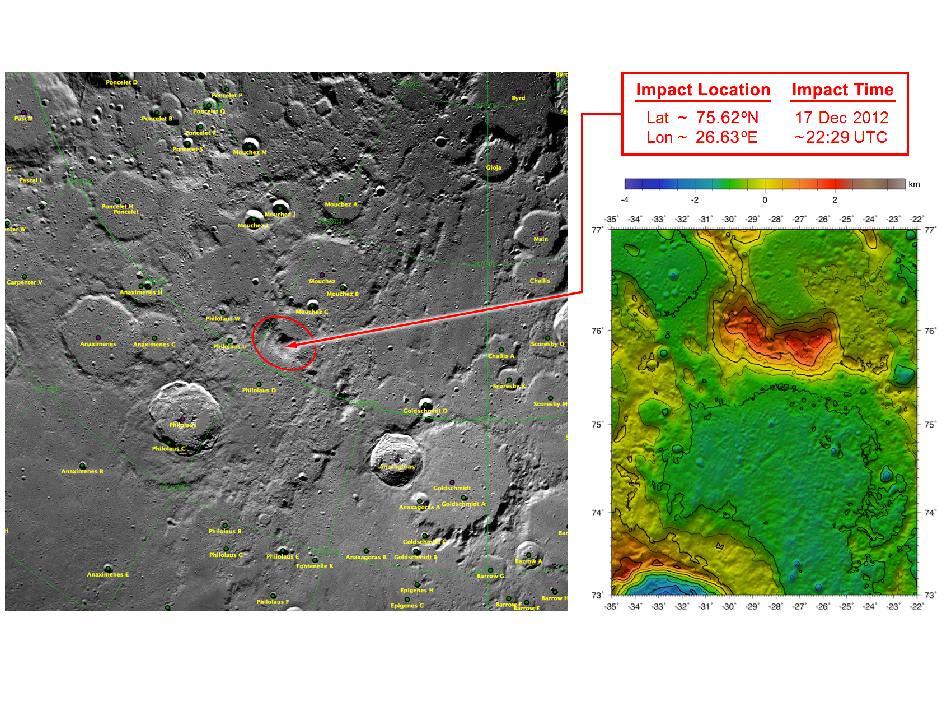The GRAIL mission will come to a dramatic end on Monday as the two spacecraft will be commanded to crash into the rim of an unnamed crater near the Moon’s north pole. This is all according to plan, as the two spacecraft are running out of fuel after being in lunar orbit since New Year’s Day 2012.
“We successfully completed our primary science mission,” said Principal Investigator Maria Zuber, “ and, frankly, in my wildest dreams I don’t think this mission could have gone any better than it has. But when you orbit a planetary body that has lumpy gravity field, you use a lot of fuel.”
On Dec. 17 at about 5:28 EST, the spacecraft dubbed Ebb will undergo a controlled impact into a 2 km high “mountain, a rim of a crater that has been buried in ejecta near north pole of the Moon (coordinates are 75.62°N, 26.63°W). About 30 seconds later Flow will impact, about 40 km apart.
Both spacecraft will hit the surface at 3,760 mph (1.7 kilometers per second). No imagery of the impact is expected because the region will be in shadow at the time.
These maps of Earth’s moon highlight the region where the twin spacecraft of NASA’s Gravity Recovery and Interior Laboratory (GRAIL) mission will impact on Dec. Image credit: NASA/GSFC
Additionally, Gruber said that while they hope the Lunar Reconnaissance Orbiter will be able to observe the impact region (at the very least image the region both before and after impact), they don’t expect to there to be a “flash” visible from Earth, and do not believe there will be a significant chance of doing science by kicking up volatiles like LCROSS did, mostly because of the GRAIL spacecraft small size (each about the size of a washing machine) and because of the low angle of impact. The spacecraft have been at a low orbit averaging about 11 km above the surface this week, to be able to map at a high resolution before the fuel ran out.
They chose a mountain-side “since we’re coming in at angle of 1.5 degrees, it would only have left “skid marks” on level surface,” Zuber said. “There was interest in the team in impacting a structure, or a wall, so we could learn about mechanical properties of a crater rim. We’ll be looking at the rim of the crater and understanding how much is intact rock and how much is broken up. It will be very low probability but high scientific payoff if it works, if any volatiles they would be liberated from the impacts.”
The twist on this observation, Zuber said, is this crater is in sunlight most of the time, so if any volatiles come out, it would be surprising.
GRAIL project manager David Lehman said that Friday morning (December 14) the spacecraft will each be executing a maneuver will targeting the impact site, that will also position them to avoid what are called “historic heritage sites,” where the US and Russians have put soft landers on the Moon.
Then they’ll turn off the science instruments, followed by a series of engineering demonstrations to help with future missions over the weekend. About 54 minutes before impact, they’ll burn the remaining fuel to complete the last maneuver.
Lehman said there is a bit of challenge in hitting the crater rim. “We need to clear a ridge and then keep from going through a gap in the rim, because otherwise it would keep going and hit the far side of the Moon.”
Lehman added he was sad to see the mission end. “I’m kind of hoping tonight that a gas station will pull up to our spacecraft and refuel it.”
During their prime mission, from March through May, Ebb and Flow collected data while orbiting at an average altitude of 34 miles (55 kilometers). Their altitude was lowered to 14 miles (23 kilometers) for their extended mission, which began Aug. 30 and sometimes placed them within a few miles of the moon’s tallest surface features.
The duo’s successful prime and extended science missions generated the highest-resolution gravity field map of any celestial body. The map will provide a better understanding of how Earth and other rocky planets in the solar system formed and evolved.
“It is going to be difficult to say goodbye,” said Zuber. “Our little robotic twins have been exemplary members of the GRAIL family, and planetary science has advanced in a major way because of their contributions.”


We should name it the Grail crater from now on. Maybe Tim can tell us what we might find there.
It is amusing, and a bit bemusing, that every article I’ve read about this has mentioned that this controlled impact was done to avoid the possibllity of damaging the historic apollo sites. My, my, we are mathematically challenged, aren’t we?
as long as nothing slams into my moon crater rim i’ll be happy
What about contamination a lunar ice by the poisonous rocket fuel? Do you think that the future lunar explorers will say you: “Thanks very much”?
As noted in the article “About 54 minutes before impact, they’ll burn the remaining fuel to complete the last maneuver.”
Why can’t we help but leave a mess everywhere we go! With all those amazing minds achieving these fantastical feats you’d think that someone would have come up with a solution other than to pollute another planet/rock/etc. Slightly disappointed that no one seems to care.
Oh please! Enough already with the pristine planet crap. Who benefits and in what possible way from an untouched moon? And if I were there, I’d be super pleased to see some remnants of earth as opposed to the millions of hectares of dusty gravel.